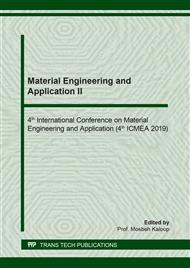p.238
p.243
p.248
p.254
p.259
p.266
p.273
p.278
p.283
Fabrication Study of Cu-C-Ni for EDM Electrode by a Sintering Technique
Abstract:
The aim of this research was to study the feasibility for applications related to powder metallurgy in EDM electrode fabrication by combination of the percentage Cu-C-Ni element. The experiment was performed by comparing preliminary distribution results of particle size before and after the grinding of metal powders. The work-piece was pressed at a pressure of 200 Psi using a uniaxial press machine. The pressed green compact work-piece was then baked in a furnace. The gas inside the furnace that was used to control the temperature during the cold press procedure had a mixture gas ratio between argon and hydrogen of 95:5 (common grade) at 1030 oC and a soaking time of one hour. The results were examined by comparing the electric resistivity property, apparent density, bulk density as well as the porosity percentage inside the work piece material. The results revealed that the optimum combination of percentage Cu-C-Ni element was Cu92-C3-Ni5 (%wt), leading to the satisfactory Copper distribution in most of the structure. The size of sub sieve powder after grinding was found to be 22-31 micron with an electric resistivity of 1.45829E-05 k-ohm*cm. The minimum porosity percentage was found to be 2.19 %. Therefore, the element properties were found to be suitable for using as an electrode in EDM work when compared to that of the electrode prototype (EDM C3).
Info:
Periodical:
Pages:
259-265
Citation:
Online since:
May 2020
Keywords:
Price:
Сopyright:
© 2020 Trans Tech Publications Ltd. All Rights Reserved
Share:
Citation:


